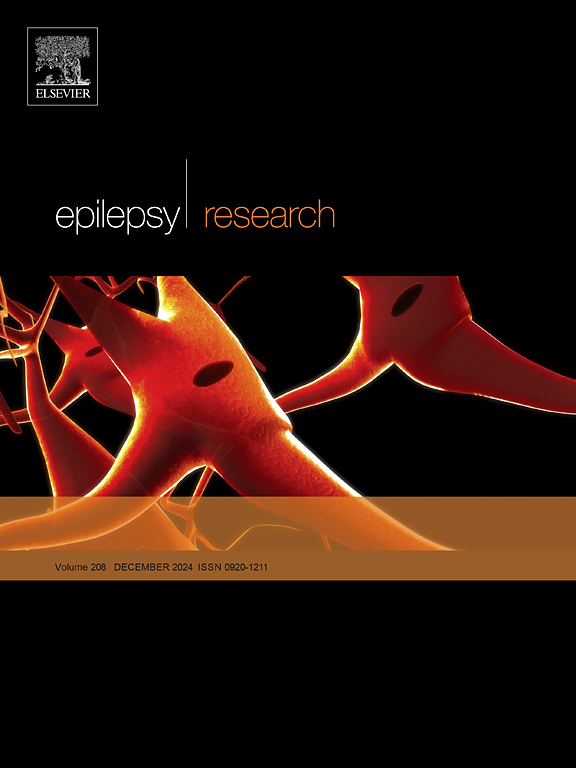局灶性皮质发育不良的星形细胞和小胶质细胞表型。
IF 2
4区 医学
Q3 CLINICAL NEUROLOGY
引用次数: 0
摘要
背景:局灶性皮质发育不良(FCD)是局灶性癫痫的常见病因,但FCD中癫痫发生的病理生理机制尚不清楚。新出现的证据表明功能失调的星形胶质细胞是癫痫的关键因素。最近,星形胶质细胞(A1/A2)和小胶质细胞(M1/M2)两种表型在神经系统疾病中被描述为具有神经炎症和神经保护作用。我们研究了FCD中的星形细胞(A1/A2)和小胶质细胞(M1/M2)表型及其在癫痫发生中的作用。材料和方法:采用免疫组织化学方法对手术切除的FCD IIa( = 10)和FCD IIb( = 10)以及年龄和区域匹配的死后对照( = 4)进行评估,使用C3d和GBP2 (a1 -星形细胞标志物)、pSTAT3 (a2 -星形细胞)、CD14 (m1 -小胶质细胞)和CD163 (m2 -小胶质细胞)、caspase 3(凋亡)和磷酸化的tau和磷酸化的神经丝(神经元变性)。胶质细胞表型的半定量评估与临床参数相关。结果:与对照组相比,在FCDIIa中,pSTAT3 + a2星形胶质细胞(平均44.1个细胞/mm2)占主导地位,缺乏C3d/GBP2 + a1星形胶质细胞。在FCDIIb中,a2 -星形胶质细胞显著高于A1 (p值=0.04)[A1 (C3d-15.79 cells/mm2; GBP2-13.67 cells/mm2);A2 (pSTAT3-78.24 cells/mm2)]。FCDIIb中的球囊细胞被C3d和GBP2强烈标记(a1表型)。在FCDIIa和IIb中,pSTAT3 + A2星形胶质细胞定位于基底下区。在FCD IIa (M1- 11.9/mm2, M2- 12.4细胞/mm2)和FCD IIb (M1-27.9/mm2, M2-18.7/mm2)的发育不良皮质中,FCD IIb中M1 >M2均出现炎症性CD14 + M1和修复性CD163 + M2小胶质细胞增加,但无统计学意义(p值>0.05)。星形胶质细胞(A1, A2)和小胶质细胞(M1, M2)的平均密度与任何临床参数均无相关性。Caspase 3在两者中标记活性星形胶质细胞和少突胶质细胞以及偶有畸形神经元,在FCDIIb中标记BC。结论:这是首次在FCD IIa和IIb中检测星形细胞和小胶质细胞表型的研究。特异性星形细胞和小胶质细胞表型的鉴定为癫痫发生的调节提供了新的治疗靶点,特别是在耐药癫痫中。本文章由计算机程序翻译,如有差异,请以英文原文为准。
Astrocytic and microglial phenotypes in focal cortical dysplasia
Background
Focal cortical dysplasia (FCD) is a common cause of focal epilepsy, however pathophysiology of epileptogenesis in FCD remains unresolved. Emerging evidence suggests that dysfunctional astrocytes are key players in epilepsy. Recently two phenotypes of astrocytes (A1/A2) and microglia (M1/M2) have been described in neurological diseases with neuroinflammatory and neuroprotective roles. We investigated astrocytic (A1/A2) and microglial (M1/M2) phenotypes in FCD and their role in epileptogenesis.
Material and Methods
Histologically confirmed cases of surgically resected FCD IIa (n = 10) and FCD IIb (n = 10) and age and region-matched post-mortem controls (n = 4) were evaluated by immunohistochemistry using C3d and GBP2 (A1-astrocytic markers), pSTAT3 (A2-astrocytes), CD14 (M1-microglia) and CD163 (M2-microglia), caspase 3 (for apoptosis) and phosphorylated-Tau and phosphorylated-neurofilament (for neuronal degeneration). Semi-quantitative assessment for glial phenotypes were correlated with clinical parameters.
Results
Compared to the control group, in FCDIIa, pSTAT3 + A2-astrocytes (mean-44.1 cells/mm2) predominated in absence of C3d/GBP2 + A1-astrocytes. In FCDIIb, A2-astrocytes were significantly higher than A1 (p-value=0.04) [A1 (C3d-15.79 cells/mm2; GBP2–13.67 cells/mm2); A2 (pSTAT3–78.24 cells/mm2)]. Balloon cells in FCDIIb strongly labelled with C3d and GBP2 (A1-phenotype). In both FCDIIa and IIb, pSTAT3 + A2 astrocytes were localised to subpial zone. Increase in both inflammatory CD14 + M1 and reparative CD163 + M2 microglia in perivascular region, was seen in the dysplastic cortex in both FCD IIa (M1- 11.9/mm2, M2- 12.4 cells/mm2) and FCD IIb (M1–27.9/mm2, M2–18.7/mm2) with M1 >M2 in FCD IIb, though not statistically significant (p-value>0.05). Mean densities of astrocytes (A1, A2) and microglia (M1, M2) did not correlate with any of the clinical parameters. Caspase 3 labelled reactive astrocytes and oligodendrocytes and occasional dysmorphic neurons in both, and BC in FCDIIb.
Conclusions
This is the first study examining astrocytic and microglial phenotypes in FCD IIa and IIb. Identification of specific astrocytic and microglial phenotypes offers novel therapeutic targets for modulation of epileptogenesis, especially in drug resistant epilepsy.
求助全文
通过发布文献求助,成功后即可免费获取论文全文。
去求助
来源期刊

Epilepsy Research
医学-临床神经学
CiteScore
0.10
自引率
4.50%
发文量
143
审稿时长
62 days
期刊介绍:
Epilepsy Research provides for publication of high quality articles in both basic and clinical epilepsy research, with a special emphasis on translational research that ultimately relates to epilepsy as a human condition. The journal is intended to provide a forum for reporting the best and most rigorous epilepsy research from all disciplines ranging from biophysics and molecular biology to epidemiological and psychosocial research. As such the journal will publish original papers relevant to epilepsy from any scientific discipline and also studies of a multidisciplinary nature. Clinical and experimental research papers adopting fresh conceptual approaches to the study of epilepsy and its treatment are encouraged. The overriding criteria for publication are novelty, significant clinical or experimental relevance, and interest to a multidisciplinary audience in the broad arena of epilepsy. Review articles focused on any topic of epilepsy research will also be considered, but only if they present an exceptionally clear synthesis of current knowledge and future directions of a research area, based on a critical assessment of the available data or on hypotheses that are likely to stimulate more critical thinking and further advances in an area of epilepsy research.
 求助内容:
求助内容: 应助结果提醒方式:
应助结果提醒方式:


